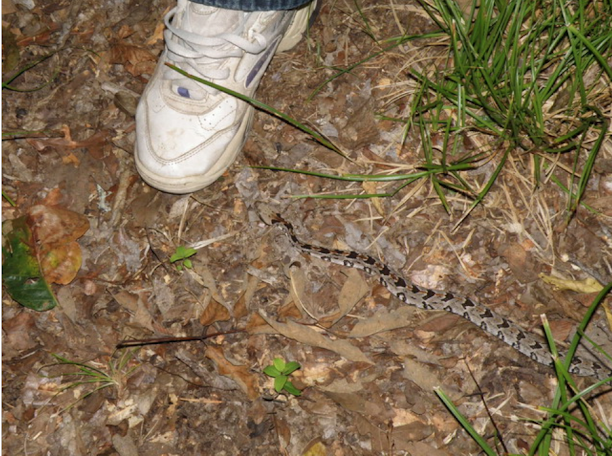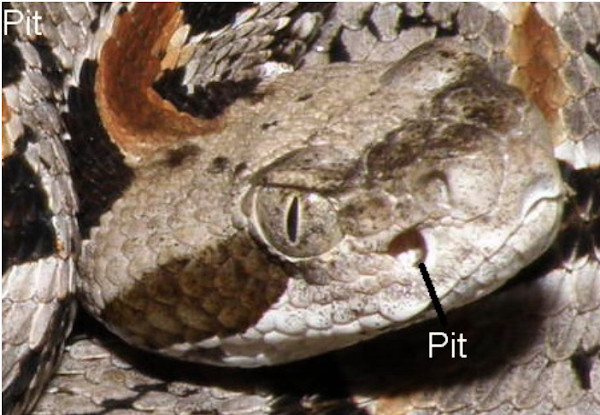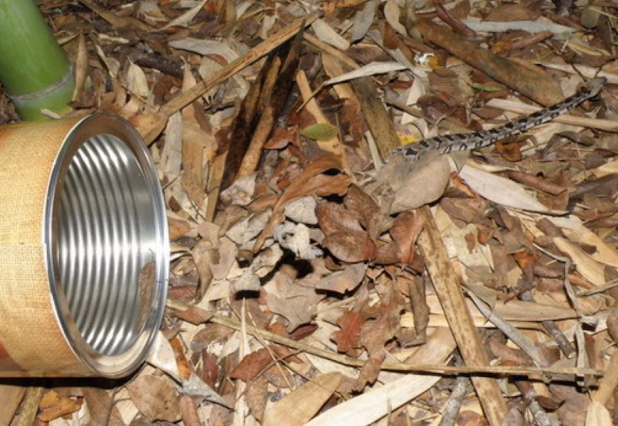Texas and Cute Little Snake
October 4, 2009
Stepping out the back door of my home (located in the Texas woodlands), I found this cute little snake all coiled up and looking peaceful. Of course, my first concern was to determine if it was a poisonous snake. It didn’t have a set of rattles, so it must not be a rattlesnake. Based on the color and the markings, it was definitely not one of our local Coral Snakes, Copperheads or Cottonmouths.
It didn’t look quite like one of those Rat Snakes that routinely scare the bejesus out of the local nesting Titmice and Chickadees. The dark markings on the back were not diamond-shaped and it was too far from the water to be a Diamondback Water Snake. It did not have a long and skinny body shape and did not try to escape like one of the Garter Snakes. “Maybe it’s a Southern Hognose Snake,” I thought -- but the neck did not flare like a Hognose. Bingo! The head was much wider than the neck. “Maybe it’s a pit viper,” I thought.
By now, the little snake must have tired of the camera flash and the proximity of humans and decided to crawl away. Pat (my wife) boldly headed it off so that it would not escape under the shed. But that little snake turned aggressive and forced Pat to back off.
Well, I did not remember all the characteristics of a pit viper, so while Pat and the snake played “blind man’s bluff” with each other, I consulted my handy reference. According to my snake book, a pit viper’s head is wider than its neck, eyes have vertical pupils and there is a pit between the eye and nose.
OK, these characteristics seem to fit, so maybe we should give this snake a little more respect. It then dawned on me that maybe this snake was small because it was young. On closer examination, I found something on the end of its tail that looked like a black button. Yikes! This little guy must be a one-year-old rattlesnake with a single rattle. Well, we have seen several rattlesnakes on this land over the last 35 years or so and, as best I can tell, they were all Timber Rattlesnakes – one almost 7 feet long. Our little snake had a reddish stripe down its back and a dark stripe behind its eye – both characteristics that identified it as a Timber Rattlesnake.
If our grandchildren had been here, I might have killed this little rattlesnake. But snakes keep down our mice numbers and we just don’t like to kill our wildlife, so we let it go. It disappeared under the deck of our house and I expected that it would crawl off into the woods – never to be seen again.
That night, as I walked through the darkness of our semi-moonlit yard, I remembered that little snake and realized that baby rattlesnakes have mommy or daddy snakes that might also be around and about. I quickly found a flashlight to carefully illuminate my path.
It was somehow not a total surprise the next morning, when I found that this little snake had climbed up on our deck and was sunning itself just outside the sliding doors.
At that point, I seriously considered separating its little head from its body. I’ve killed lots of snakes in my life, so killing one more would be no big deal. But I didn’t. Instead, I coaxed it into a gallon can and cautiously placed a lid on top. Now it was ready to be transported and released into some far corner of our property. We realize that this little snake may grow into a large snake that may someday bite and kill one of us. But life is full of hazards and the odds are that this snake will not survive to adulthood. Chances are that a Barred Owl, Red Shouldered Hawk or some other predator will make a meal of our little snake. But at least it has a chance.
As I carefully removed the lid from the can, our snake finally made an unnerving little rattling sound. We decided that the sound came from that one single button hitting the side of the tin can as it attempted an adult-like rattle. We watched as our snake cautiously crawled out of the can and headed into the shelter of a bamboo patch. I felt good about our choice, but ...





No comments:
Post a Comment